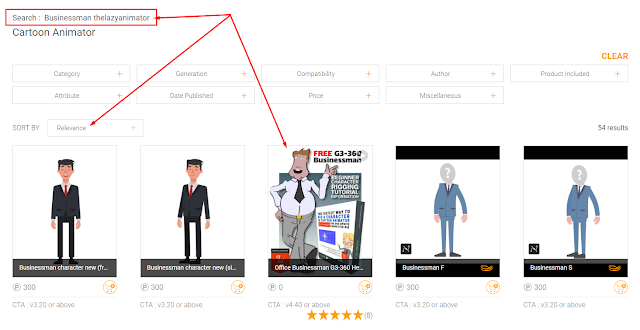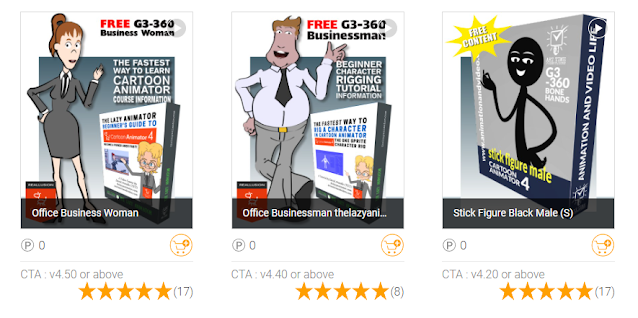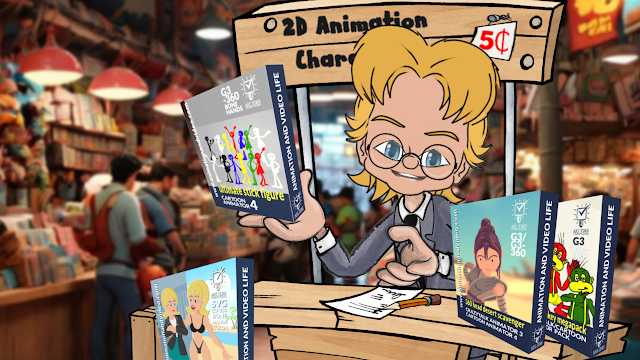2D Animation Side Hustle - How to Package, Upload, Optimize, Price, and Promote Your Content in the Reallusion 2D Marketplace
This is the final post in my four part, 2D Animation Side Hustle series on Selling in the Reallusion 2D Marketplace. I'll look at how to package up your content and upload it to the Marketplace, how to optimize your listings, price, and how to sell through your store backend as well as off site through social media and other channels.
If you haven't read previous articles in the series click these links for Part 1 - Can You Make Real Money, Part 2 - Finding Niches, and Part 3 - What to Sell.
Before getting started you'll need to register as a Content Developer in order to see the backend of your store on the Reallusion Marketplace.
Packaging Content and Uploading to the Marketplace
Since the release of Cartoon Animator 5 the software has a built in Package Manager that makes it easy to assemble and upload your Content to the Marketplace. Reallusion has a comprehensive, official video (embeded below) that quickly explains the entire process in less than seven minutes.
It's better that you just watch it and I'll add a my notes about optimizing your listings after the video. Be sure to take everything in as it's easy to miss important steps (particularly like making sure you put your content within folders under each subsection for better organization in your customer's Content Manager).
Management Backend.
One thing to note is that the Management Backend of your store, which you can access from the Reallusion site's profile menu once you're in the Marketplace, has received a major upgrade since the above video. Most being cosmetic and organizational changes. You should still be able to find your way around.
After you have uploaded your Content from Cartoon Animator's Package Manager you'll need to login to your store's management backend to complete the listing, specifically adding all the Product page images, sample video (optional), product tags, and pricing.
 |
| The Content Management section of your store's Backend is where you can edit all the additional information on your listing and add additional preview graphics. |
To save yourself some time I would recommend making some of your additional product header/preview images into images you can also share on social media to promote your content.
Optimizing Your Listings
(The Most Important Thing You'll Read Today!)
Reallusion does have a downloadable PDF of best practices for Commercializing your Products that covers all the basics including; thumbnail design, what preview images to include in your product page header, and whether to include video previews. It's excellent information but what it doesn't talk about is Search Engine Optimization (SEO)
 |
| Main Banner Image Guideline - Page 4 from Reallusion's own Commercialization PDF. |
When filling out your titles, description, and tags, you need to search engine optimize them. Which means, including keywords that people would actually enter into the Marketplace search box in order to find your content.
Logically, you might think your name or shop name is a good keyword to include, however it's only good for people who already know you, and are trying to find your specific content again. Once people know your actual store name, just entering that will bring up all your content in search, so it's not that critical to use your own name or store name as keywords.
If you're new to SEO then it's important to know is that the term 'keywords' is interchangeable with 'key phrases'. A keyword is a word or phrase that someone would enter into the search box to find what they're looking for e.g. 'Businessman' and 'Office Businessman wearing a suit' are both keywords, with the second being more specific (or more niche).
In terms of the Marketplace's search box this is what I have observed.
The title of your product takes priority over everything else. Any product that has any of the exact words in the search box in its title will appear first in the search results. Does not matter if any product in the result doesn't have the search term or words in the description or tags, it'll still be listed higher in the results.
 |
| Only my Businessman has the keyword 'thelazyanimator' in the description yet it doesn't rank first in the search results? |
Description and tags only come into play in how the results are ordered (or if no titles contain the search term). From what I can tell the search counts up how often the search words appear in the description and tags and bases the order from most to least. I don't know this for a fact, this is just what I observed in my testing.
When naming your products, I strongly suggest you include keywords in the title, that people would actually use, to make sure your content is positioned on at least the first page of their results, but ideally in the first row. Then include those same words in the description and tags.
As an example. If you have a character who you're titling 'Barry the Office Manager', 'Office' and 'Manager' are both keywords someone is likely to search for. Nobody is looking for an Office Manager specifically named 'Barry'. You might also extend the title to include other terms people might actually use e.g. 'Barry the Office Manager, Businessman, Office Worker, Boss'.
 |
| The exact same search term only this time I've added 'thelazyanimator' keyword to my Businessman's title. Now he's the first result in the search. |
You should then include the same words in the description, and tags. You could even add a few more like 'male worker', 'Senior manager', 'Old man' (if Barry looks like an old man).
It's all about finding the right combination of words that both describe your product and are words that people are likely to use in the search box. Once your product is live be sure to test your keywords to see where your listing shows up. If you're not on the first page experiment with different keywords.
I can tell from my research, most developers aren't even thinking about SEO on their listings. That's why my stick figures sell so well. Only one other developer uses the phrase 'stick figure' in their product title (and their stick figure isn't what comes to mind when most people think of stick figures. You won't even see another stick figure character that looks like a classic stick figure until you get near the bottom of page two of the search results).
Pricing
As I mentioned in the very first post in this series, the marketplace is what's known as a low cost, high volume business. If you're selling single items like a single view character, you'll need to sell a lot of them to make a decent income.
Generally, to determine your prices, you can look at similar items to your content already selling, and price similarly (or the same). You may be able to charge higher if your item is in demand but has little or no competition. You may also think about charging higher if you believe your work is more of a 'premium' product compared to the competition.
Content Packs are a great way to earn more money with fewer sales. This is where you bundle together multiple items, based on a theme, into a pack. The general rule of pricing such a pack is ensuring the final price is less than the cost of buying each item individually (not that you have to make any part of a bundle available as individual purchases) and that the reduced amount is significant enough for customers to feel the pack is a good deal.
Free Versus Trial Content
Many developers in the marketplace offer free content. The purpose of this is to get the customer using your content in their productions so they'll hopefully want more content in your art style.
Your free content should rarely be a stand alone item. It should ideally be a sample from a series or a pack. For example if you offer a character for free, you should have a series of 'friend' characters, in the same style, that you promote alongside your free character. Customers need to know you have more in the series the work perfectly with the free item.
 |
| I use free content to both promote my courses and to promote my other characters. |
Trial Content serves a similar purpose but the customer's project will be watermarked until they actually purchase any trial content they've used. Personally I feel trial content is better suited for content packs.
Arguably, once a customer sees how trial content works within their project, you're more likely to get a sale than free content, as they're now committed to using it or finding a replacement (with the latter being the more difficult option).
Promoting/Selling Your Content
If you've done your niche research and SEO on your listings you should get quite a few sales without any further effort at all. That's the whole point of being in the Reallusion Marketplace rather than selling from your own website. You have access to buyers who are already searching for Cartoon Animator Content.
That said, maybe your content is something that people don't know they need (they're not even searching for it), but will absolutely buy if you can get it in front of them. As a developer you will periodically get emails from Reallusion's marketing team about promotions they're doing that you can participate in. So watch for these and respond accordingly.
One ongoing weekly Reallusion promotion is the Reallusion Newsletter Marketplace, Weekly Deal.
Reallusion's Newsletter goes out to Subscribers every Thursday. While you do have to offer an extreme discount for the Weekly Deal, it is a great way to get in front of people who actually use Cartoon Animator (and Reallusion's other products too). Note that your content has to be approved and scheduled by Reallusion's Marketing Team.
 |
| Weekly Deal Example - Love Juice Mega Pack by IceWorkz. The Weekly Deal can boost sales and bring attention to your store. Just be aware that it requires a significant discount. |
Beyond this you can run your own promotions through the Promotions page of your store backend - and then let the marketing team know. If approved they may include it with their promotions, or at least post it to Reallusion's social media.
A little known feature of the Management Backend is that you can actually message everyone who has bought your content previously. You can even gift free items from your store as part of your messages.
It's easier to sell to existing customers than it is to find and sell to new ones. Whenever you release new content, at the very least, it's worth messaging anyone who has bought content in that same series from you, to let them know you have an exciting new release!
Beyond Reallusion, you should absolutely be joining any social media groups related to Cartoon Animator where they allow you to promote and sell your marketplace content. If you're on Facebook The Cartoon Animator Marketplace Group was specifically set up for this purpose and has 2000+ members.
A Word on Ratings and Reviews
Reallusion does have its own program to encourage people to leave Ratings and Reviews. Users can earn up to 1000 Bonus points for rating three items they have purchased, from three different sellers, between January and June 2024 (at the time of writing this article), and are usually sent an email by Reallusion to remind them.
You can see all your customer reviews in your message center. While replying to ratings is a great way to foster direct customer engagement, people can also sort their search results by the number of ratings received. Nothing says a product is good like a lot of ratings. It may be worth being more pro-active on asking for ratings and reviews for those people looking for social proof that your content is great.
Conclusion
If you've read this entire four part series on selling in the Reallusion 2D Marketplace I really hope you have found it informative, with perhaps more than a few ideas for how you can make it a profitable side hustle (or even a full time hustle).
Obviously there is a lot more I could have covered, and a lot that I could have gone into far more detail about. However the purpose of this series was to give a look behind the scenes at what you can do to take advantage or this real opportunity, to make worthwhile money, while helping your fellow animators express their ideas with your content.
Hopefully you've learned there's plenty of avenues and resources to explore to make sure your marketplace store is a thriving success.
o---o--- ---o--- o---
Did you find this article useful?
Subscribe to my newsletter and get the
latest articles delivered to your inbox.
Did you find this article useful?
Subscribe to my newsletter and get the
latest articles delivered to your inbox.



